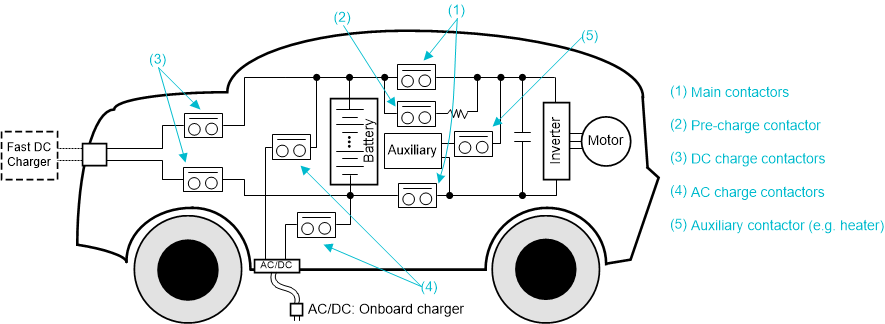-
Driving High-Voltage Contactors in EV and HEVs SLVAF35A February 2021 – July 2024 DRV8714-Q1 , TPS2HB16-Q1
-
Driving High-Voltage Contactors in EV and HEVs
Driving High-Voltage Contactors in EV and HEVs
Abstract
This article provides a general introduction of the high-voltage contactors in EV and HEVs, and presents several approaches on how to drive the high-voltage contactors.
Trademarks
All trademarks are the property of their respective owners.
1 Introduction
A high-voltage contactor, also called a high-voltage relay without distinction in the industry, is widely used in electric vehicles (EV) and hybrid electric vehicles (HEV). It is an electromechanical switching device with a coil to generate a magnetic force that mechanically operates an electric contact. However, it is more common to use a high-voltage contactor to represent high-power applications in EV and HEVs.
As a key safety device in new energy vehicles, a high-voltage contactor needs basic functions that are resistant to high voltage, load, shock, strong arc extinguishing, and breaking capacity. An appropriate current is applied to the coil such as using an IC, such as DRV3946, to ensure proper force to drive the contacts for robust operation. Even though there are many different types of contactors for different functions in a vehicle, the driving current profiles of all the contactor coils are similar.
2 Contactors Distribution in EVs and HEVs
 Figure 2-1 Contactors Distribution in EV
and HEVs
Figure 2-1 Contactors Distribution in EV
and HEVsIn plug-in HEVs, a pair of additional AC charge contactors is inserted to establish a connection between the traction battery and the onboard charger. The onboard charger of the vehicle gets power from an AC charger, converts that AC power to DC to charge the battery.
For battery EVs, another pair of DC fast charge contactors is inserted to establish a connection between the traction battery and the DC fast-charge equipment. The DC fast charging is essential for long distance driving and large battery EV fleets. An auxiliary contactor like the electric heater for the passenger compartment is mandatory because there is no waste heat available from a combustion engine.
Main contactors, pre-charge contactors, and DC charge contactors are mostly located in the battery junction box (or battery disconnect unit). AC charge contactors are likely to be placed in the battery power distribution unit which is adjacent to the onboard charger.